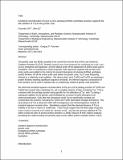Ancestral Reconstruction of a Pre-LUCA Aminoacyl-tRNA Synthetase Ancestor Supports the Late Addition of Trp to the Genetic Code
Author(s)
Fournier, G. P.; Alm, E. J.; Fournier, Gregory P.; Alm, Eric J
Download239_2015_9672_ReferencePDF.pdf (498.2Kb)
OPEN_ACCESS_POLICY
Open Access Policy
Creative Commons Attribution-Noncommercial-Share Alike
Terms of use
Metadata
Show full item recordAbstract
The genetic code was likely complete in its current form by the time of the last universal common ancestor (LUCA). Several scenarios have been proposed for explaining the code’s pre-LUCA emergence and expansion, and the relative order of the appearance of amino acids used in translation. One co-evolutionary model of genetic code expansion proposes that at least some amino acids were added to the code by the ancient divergence of aminoacyl-tRNA synthetase (aaRS) families. Of all the amino acids used within the genetic code, Trp is most frequently claimed as a relatively recent addition. We observe that, since TrpRS and TyrRS are paralogous protein families retaining significant sequence similarity, the inferred sequence composition of their ancestor can be used to evaluate this co-evolutionary model of genetic code expansion. We show that ancestral sequence reconstructions of the pre-LUCA paralog ancestor of TyrRS and TrpRS have several sites containing Tyr, yet a complete absence of sites containing Trp. This is consistent with the paralog ancestor being specific for the utilization of Tyr, with Trp being a subsequent addition to the genetic code facilitated by a process of aaRS divergence and neofunctionalization. Only after this divergence could Trp be specifically encoded and incorporated into proteins, including the TyrRS and TrpRS descendant lineages themselves. This early absence of Trp is observed under both homogeneous and non-homogeneous models of ancestral sequence reconstruction. Simulations support that this observed absence of Trp is unlikely to be due to chance or model bias. These results support that the final stages of genetic code evolution occurred well within the “protein world,” and that the presence–absence of Trp within conserved sites of ancient protein domains is a likely measure of their relative antiquity, permitting the relative timing of extremely early events within protein evolution before LUCA.
Date issued
2015-03Department
Massachusetts Institute of Technology. Department of Biological Engineering; Massachusetts Institute of Technology. Department of Earth, Atmospheric, and Planetary SciencesJournal
Journal of Molecular Evolution
Publisher
Springer US
Citation
Fournier, G. P., and E. J. Alm. “Ancestral Reconstruction of a Pre-LUCA Aminoacyl-tRNA Synthetase Ancestor Supports the Late Addition of Trp to the Genetic Code.” Journal of Molecular Evolution 80.3–4 (2015): 171–185.
Version: Author's final manuscript
ISSN
0022-2844
1432-1432